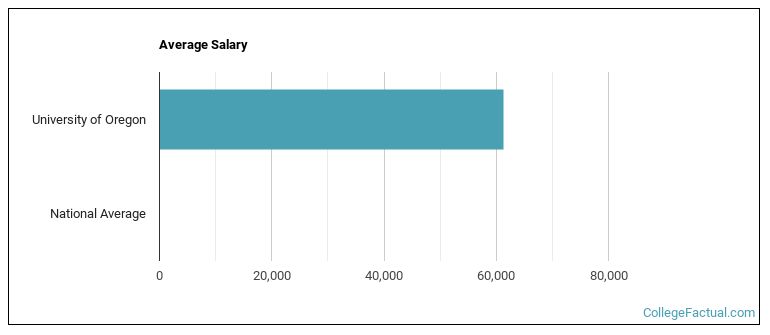 by our College Data Analytics Team
by our College Data Analytics Team
College Factual analyzes over 2,000 colleges and universities in its annual rankings and ranks them in a variety of ways, including most diverse, best overall quality, best for non-traditional students, and much more.
University of Oregon was awarded 78 badges in the 2025 rankings. The highest ranked major at the school is general human services.
Explore the best ranked schools for the programs you are most interested in.
College Factual ranked UO as #167 out of 2,152 colleges and universities in the country on its 2025 Best Colleges list. This puts it in the top 10% of all schools in the nation. This is an improvement over the previous year, when UO held the #195 spot on the Best Overall Colleges list.
Out of the 29 colleges in Oregon, UO is ranked at #1.
With an acceptance rate of 86%, UO has a fairly liberal admissions policy. However, don't just assume you'll get in! Put together a good application and make sure you include all requested documents and materials.
About 11% of students accepted to UO submitted their SAT scores. When looking at the 25th through the 75th percentile, SAT Evidence-Based Reading and Writing scores ranged between 580 and 690. Math scores were between 560 and 680.
At University of Oregon, the student to faculty ratio is 20 to 1. Compared to the national average of 15 to 1, this is somewhat high. This could mean that class sizes may be larger than they are at other colleges or universities or that professors may be required to teach more classes.
Another measure that is often used to estimate how much access students will have to their professors is how many faculty members are full-time. The idea here is that part-time faculty tend to spend less time on campus, so they may not be as available to students as full-timers.
The full-time faculty percentage at University of Oregon is 70%. This is higher than the national average of 47%.
University of Oregon has a freshmen retention rate of 86%. That's a good sign that full-time students like the school and their professors enough to want to stick around for another year. It's also a sign that the admissions team did a good job in choosing applicants who were a good fit for the school.
The on-time graduation rate for someone pursuing a bachelor's degree is typically four years. This rate at UO for first-time, full-time students is 58%, which is better than the national average of 33.3%.
Find out more about the retention and graduation rates at University of Oregon.
During the 2017-2018 academic year, there were 18,045 undergraduates at UO with 16,400 being full-time and 1,645 being part-time.
| $0-30 K | $30K-48K | $48-75 | $75-110K | $110K + |
|---|---|---|---|---|
| $15,038 | $14,871 | $17,109 | $25,269 | $28,072 |
The net price is calculated by adding tuition, room, board and other costs and subtracting financial aid.Note that the net price is typically less than the published for a school. For more information on the sticker price of UO, see our tuition and fees and room and board pages.
It's not uncommon for college students to take out loans to pay for school. In fact, almost 66% of students nationwide depend at least partially on loans. At UO, approximately 36% of students took out student loans averaging $7,821 a year. That adds up to $31,284 over four years for those students.

See which majors at University of Oregon make the most money.
Get more details about the location of University of Oregon.

Contact details for UO are given below.
| Contact Details | |
|---|---|
| Address: | 110 Johnson Hall, Eugene, OR 97403 |
| Phone: | 541-346-1000 |
| Website: | https://www.uoregon.edu/ |
| Most Popular Majors | Bachelor’s Degrees | Average Salary of Graduates |
|---|---|---|
| General Business/Commerce | 535 | $46,897 |
| Public Relations & Advertising | 499 | $42,159 |
| General Psychology | 411 | $31,398 |
| General Social Sciences | 236 | $38,147 |
| Teacher Education Grade Specific | 224 | NA |
| Economics | 220 | $45,941 |
| Business Administration & Management | 218 | NA |
| Physiology & Pathology Sciences | 204 | $27,502 |
| Political Science & Government | 203 | $36,022 |
| Journalism | 158 | $33,525 |
Online learning is becoming popular at even the oldest colleges and universities in the United States. Not only are online classes great for returning adults with busy schedules, they are also frequented by a growing number of traditional students.
In 2022-2023, 7,077 students took at least one online class at University of Oregon. This is a decrease from the 9,364 students who took online classes the previous year.
| Year | Took at Least One Online Class | Took All Classes Online |
|---|---|---|
| 2022-2023 | 7,077 | 355 |
| 2021-2022 | 9,364 | 545 |
| 2020-2021 | 11,256 | 463 |
| 2018-2019 | 3,145 | 219 |
If you’re considering University of Oregon, here are some more schools you may be interested in knowing more about.
Curious on how these schools stack up against UO? Pit them head to head with College Combat, our free interactive tool that lets you compare college on the features that matter most to you!
Footnotes
*The racial-ethnic minorities count is calculated by taking the total number of students and subtracting white students, international students, and students whose race/ethnicity was unknown. This number is then divided by the total number of students at the school to obtain the racial-ethnic minorities percentage.
References
More about our data sources and methodologies.